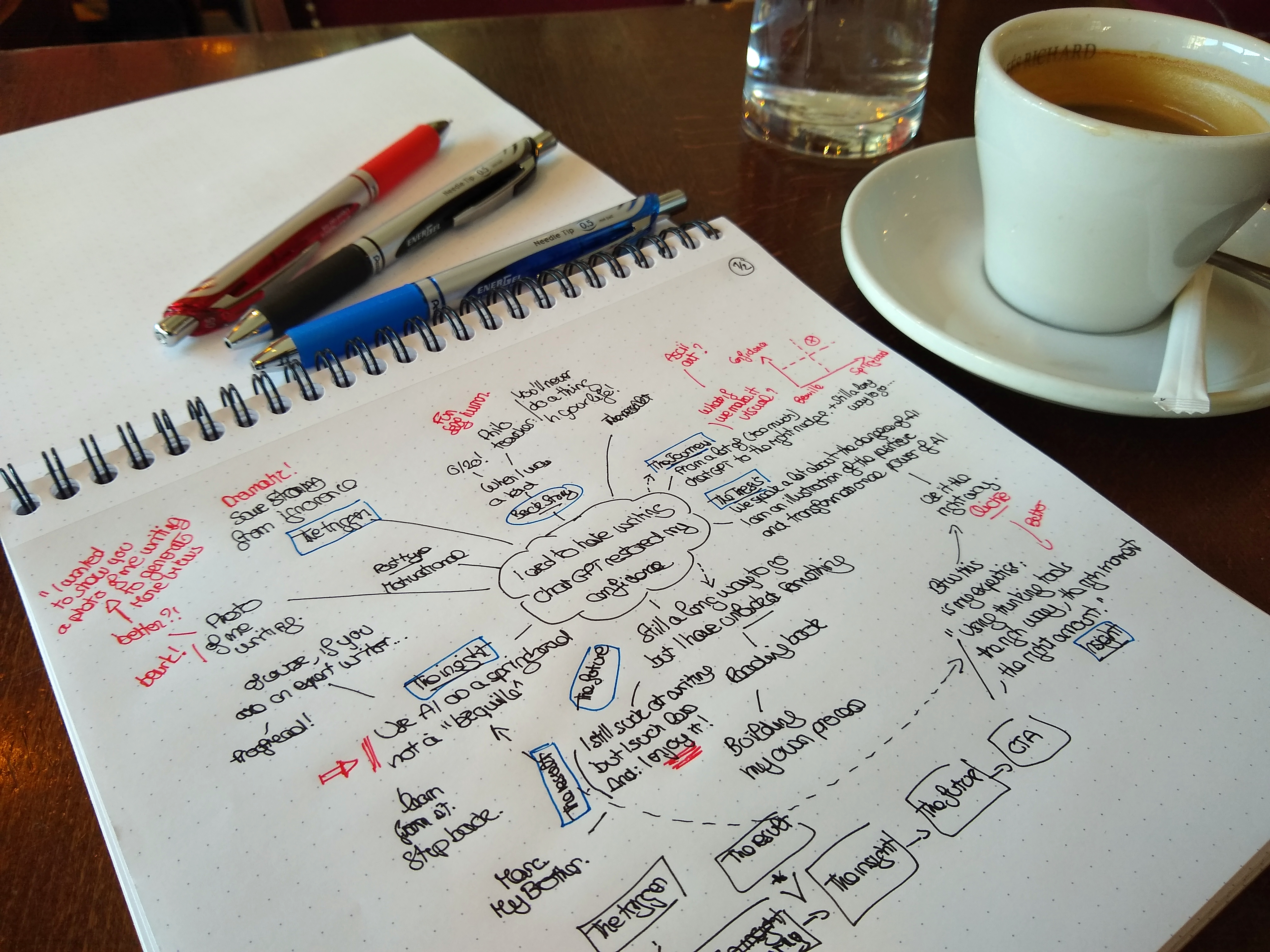I've got something that I believe will help many of you. If you're anything like me, writing isn't exactly your favorite pastime. But in today's digital world, writing, especially for platforms like LinkedIn, is an essential skill. That's why I've been working on something special, a playbook I've titled "From Dread to Success: The LinkedIn Writing Playbook for Non-Writers."
Now, here's the thing: I couldn't wait to share the value I'm packing into this playbook. So, I've decided to give you a sneak peek by sharing the first two chapters with you:
Chapter 3. The Process: A Fun and Creative Way to Keep LinkedIn Posts Coming
Let me share with you the recipe I came up with for my writing. I've designed this process specifically for people who, just like me, shudder at the thought of writing. I promise, it's designed to be fun, exciting, and productive.
What's So Great About This Process?
Why should you consider following my method? Well, it packs in some pretty cool features.
- Enjoy the fun in variety: Instead of looking at writing as a tedious task, you're going to tackle it from various angles. Think of brainstorming via mindmaps, drafting, and then playing around with tools like ChatGPT.
- Embrace creative thinking: As a creativity enthusiast, I've taken special care to make sure there are moments of deliberate creativity in this process. This gives your piece a chance to really stand out.
- Maximize incubation: Here's the kicker - we're not going to write a piece in one go. Instead, we'll have multiple posts running in parallel, each at a different stage. This means you're giving each piece ample time to incubate, leading to higher quality and more unique content.
- Smart AI usage: This is something I've worked on meticulously. The idea is to use AI at the right level and in the right way. I've created specific prompts that stimulate thought rather than make you feel like a robot.
Mapping It Out: The Process Visual Diagram
Here's a visual way to represent the process.
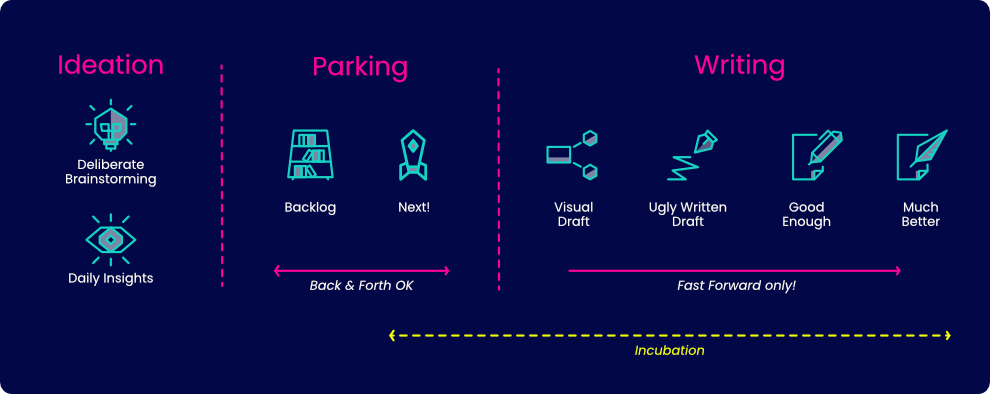
Notice the three phases? Each has its own unique rules or mechanisms. In a nutshell, 'Ideating' is an ongoing, iterative process; 'Parking' is where you store promising ideas; and 'Writing' is where the magic happens.
Stage 1 - Ideation
Step 1: Generate and Select Promising Ideas
In this phase, I either spend 10 or 60 minutes coming up with a barrage of ideas. Pushing through to the third wave of ideation (boring > weird > great), I end up with heaps of potential ideas. Only the ones I deem promising make it to my backlog.
AI can be a great ally in this step, which is why I created Sparkitup and our free Linkedin Post Brainstorming Board!
Step 2: Capture Insights on the Go
Ideas can pop up at the most unexpected moments, and it's important to have a way to capture them. That's why I have a system to note them down and add them to my backlog.
The ideation phase, step 1 and 2, is an iterative continuous process.
Stage 2 - Parking
Step 3: Park Promising Ideas
Here's where I store all my potential ideas. I aim to have at least a month's worth of post ideas, ideally three. Ideas that linger too long without action usually get removed.
Step 4: Select the Next Big Ideas
At this point, I shortlist about five ideas that I'm most excited about or are most relevant to my immediate goals. This process kickstarts the incubation process. To capture any spur-of-the-moment insights, I dedicate a page in my notebook to each 'Next' post idea. This way, if an idea suddenly pops into my head, I can quickly jot it down.
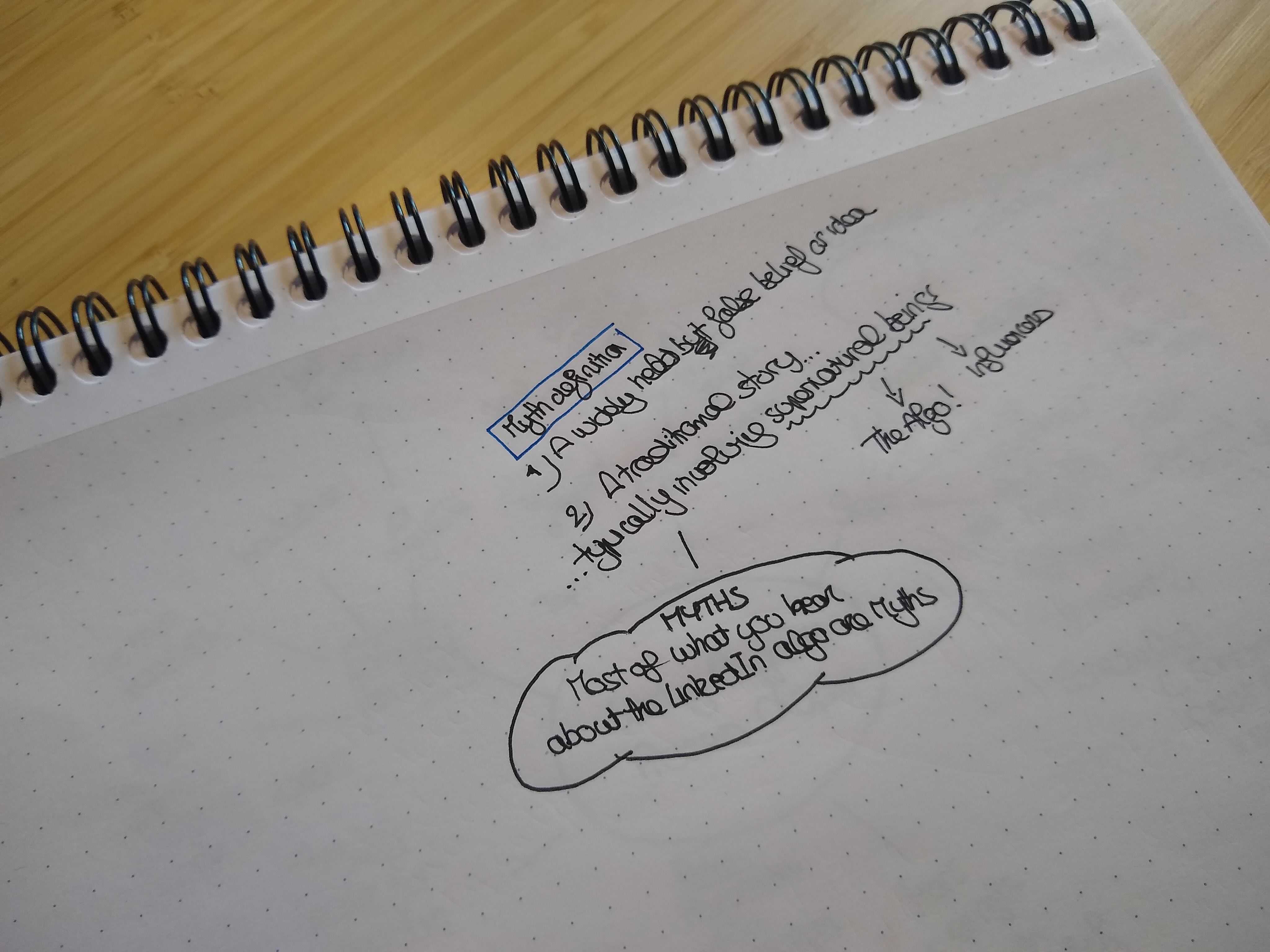
During the parking phase, step 3 and 4, post ideas can move forward or backward and still get removed.
Stage 3 - Writing
Step 5: Draft the Concept Visually
This is my favorite part. Why? Because it's all about taking that seed of a post idea in your mind and giving it a visual form. Here, I let my mind wander and start to jot down all the thoughts related to the post idea onto a concept map.
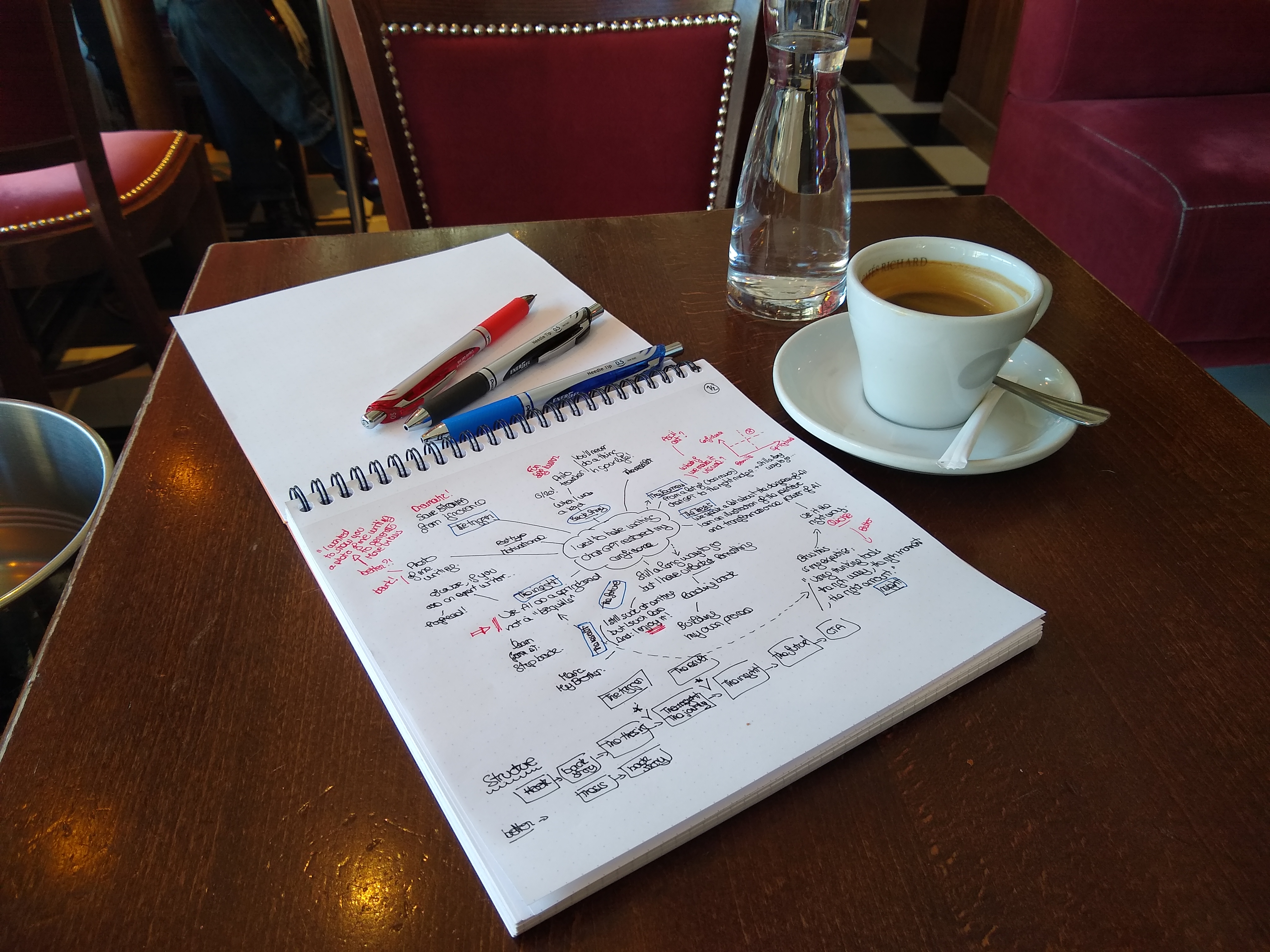
This map is a hybrid between a mindmap and a process map. It's an excellent way to start capturing all the thoughts that pass through my mind. As I scribble and draw, a structure begins to emerge. Once I have this visual representation, it's time to get creative.
I grab my red pen and start adding in unique elements, playing with new perspectives, and drawing connections that might not have been obvious before.
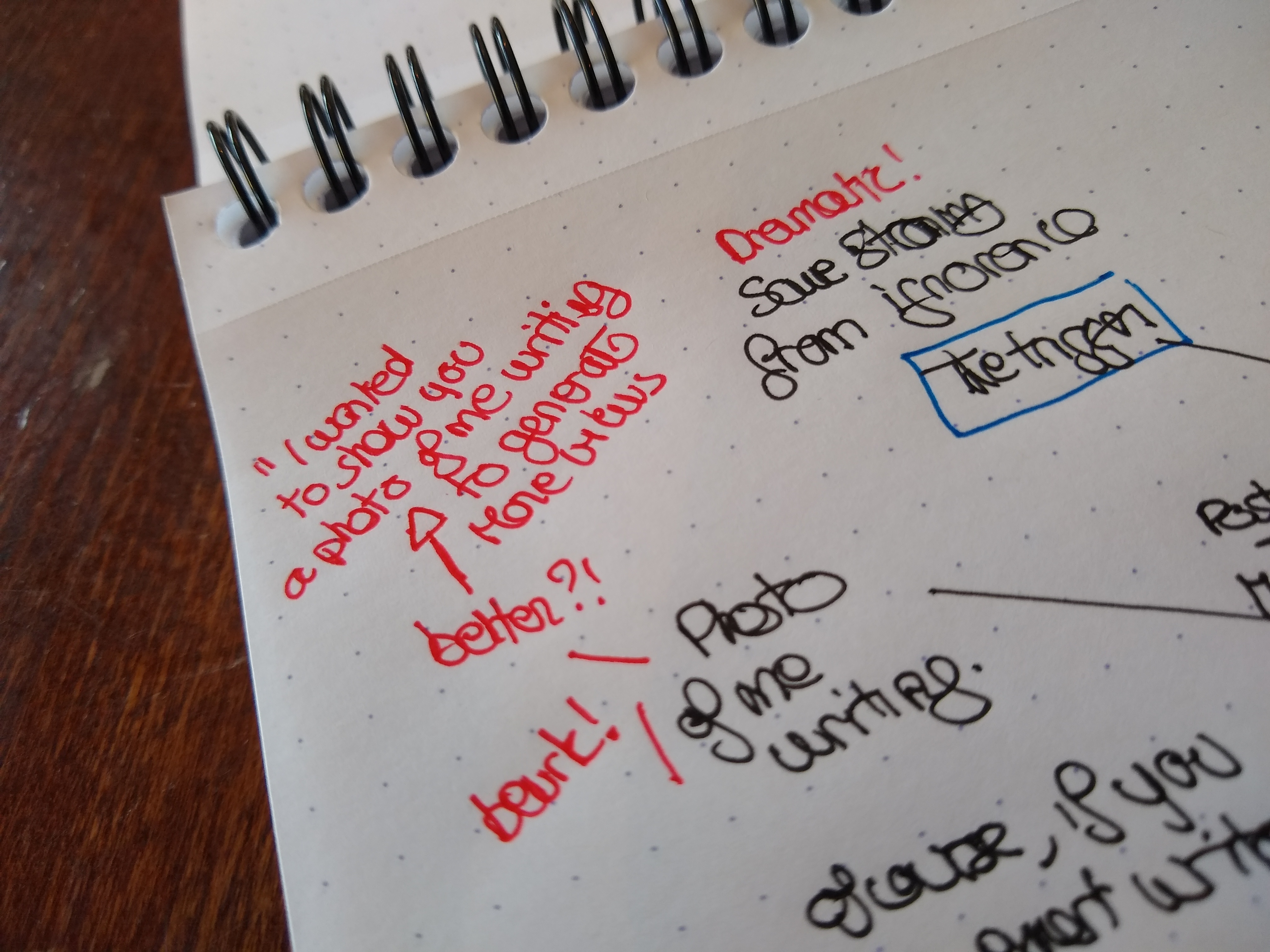
The next step is to transform this mindmap into a storyflow. I arrange the thoughts and ideas into a clear, logical flow, essentially telling the story I want my post to share. If I feel my storyflow is not attractive enough I can use my Storytelling ChatGPT prompt to help me outline a better story.
Then, I take a moment to sit back, look at the story unfolding before me, and read it aloud. This gives me a fresh perspective and often inspires a few final tweaks or additions.
Step 6: Write the First Ugly Draft
This step, inspired by Ann Handley's 'Everybody Writes,' is all about taking the plunge and getting the words on paper. It's okay if it's not perfect - this is the "ugly" draft, remember?
And here's the thing - having completed the mindmap and storyflow makes writing this initial draft surprisingly easy! I simply transform the visual story map into written form. Maybe it's too long, or maybe it's too short. It might even be all over the place. But that doesn't matter. The goal here is to translate the visual into text.
Now, a word about AI at this stage. I'd advise against using ChatGPT for rewriting your text. You want to keep your voice intact, and AI could influence it too much. However, using ChatGPT for feedback could be a great tool (more details on that in an upcoming chapter).
Remember, the aim of these two steps is to make your idea tangible and then give it a voice, no matter how rough the initial draft may seem. As we go further, we'll refine and polish until it shines!
Step 7: Refine Your Text
First, I do my best to make the draft clearer, shorter, and punchier. Then, I turn to my trusty Chat GPT with my go-to refinement prompt (more on that in the upcoming AI chapter with ChatGPT prompts of this playbook). This helps me polish my draft without losing my voice. A few more tweaks and adjustments here and there, and voilà!
Step 8: Refine Yet Again
This is the final step and it happens after a day or two. Picking up the output from step 7, I refine it again, often finding more words to cut, and more ideas to fine-tune. It's also another chance to add some humor, a pinch of creativity, and perfect those hooks and CTAs.
Then I schedule the post. Yes, always schedule! It gives yet one last opportunity for incubation. However, once scheduled resist the urge to keep pushing the post date forward – that's just procrastination!
Remember, from step 5 to 8, it's all about moving forward. And, make sure to keep a limit on the number of posts at the same stage – this ensures you're not just sticking to what you're most comfortable with.
And that's it, my friends! That's the writing process that is working for me. As a fellow solopreneur who used to dread writing, I believe it can work for you too. So, let's just get down to it and let those words flow!
Chapter 4. ChatGPT Prompts to Supercharge Your Writing and Elevate Your Thinking
Now that we have a process for cranking out a steady stream of LinkedIn posts, we are ready to team up with the renowned ChatGPT to help us with the writing.
In this chapter, I'm sharing a DREAM, 5 unique ways to use ChatGPT, add sparkle to your LinkedIn posts and... elevate your thinking.
Diverge - ChatGPT Prompts to generate ideas of posts
Reflect - ChatGPT Prompts to make me think better and deeper
Edit - ChatGPT Prompts to write or rewrite the post or some specific parts of the post (CTA, Hooks...)
Assess - ChatGPT Prompts to give me some feedback on my drafts
Morph - ChatGPT Prompt to repurpose to other kinds of media
Once you know how to use them, copy-paste them into ChatGPT and let the magic begin!
⚠️ Use With Caution - Prompts with this emoji are dangerous (see below). Remember it's crucial to follow chapter 3 process, manually refine it and ensure it aligns with your values and message.
AI Writing: Cheating or Being Smart?
Now, I can almost hear the whispers – "If you use AI, you're not a real writer." Listen up; let's get this straight. Apart from copywriters, most of us solopreneurs aren't professional wordsmiths. We're entrepreneurs, content creators, or experts in different fields. Our job isn't to write; it's to share our insights and products with the world.
So, let's not get bogged down by the naysayers.
However, there's a little catch. You've got to use the AI in the right way! If you do, you'll unlock these three perks:
- Technical Quality: Say goodbye to typos, grammar blunders, and style mishaps.
- Productivity: You'll churn out quality content faster.
And this one's super important:
- Self-improvement: You'll learn from your AI sidekick and polish your writing skills!
How to Use ChatGPT the Right Way?
By adhering to the process outlined in Chapter 3, you will have a roadmap on when to enlist the help of ChatGPT.
Note that there’s more than one prompt at your disposal. Sure, you could use the “rewrite” prompt on a quick insight and churn out a post quickly. But wait – where’s the passion, the authenticity, the YOU in it? Not to mention, you won’t be getting any better at writing.
So, unleash the full arsenal. Use the prompts strategically, just as I outlined in the process. For instance, start by hammering out that first rough draft and polishing it yourself BEFORE you turn to ChatGPT for some backup.
For the high-risk prompts, I've created the label "⚠️ Use With Caution". It's hard to miss. Now, the ball is in your court to decide whether you'll use AI responsibly or not.
One final technical tip: use these prompts in the same ChatGPT thread, so that they can build context and improve upon each other. The output will be even more refined and coherent.
Now that we've got that out of the way, let's dive into the different prompts.
DIVERGE
When used together, these two prompts will help you generate ideas for LinkedIn posts. These prompts are the same ones we use in our Free LinkedIn Post Idea Generator. You can definitely use them within ChatGPT, but trust me, our app is way more fun and offers cool features to manage all your ideas and pick the most promising ones.
ChatGPT Prompt - Content Topic Generator
Before brainstorming post ideas, it's a good idea to brainstorm broad topics first. That's exactly what this prompt is designed for.
When to use it? During Step 1, "Generate promising ideas".
ChatGPT, I am {your name}, an expert in {your expertise}. I sell {your offering} to my Target Customers {your target customers}.
I need your help in brainstorming Broad Topics for my future Linkedin Posts.
A Broad Topic check these criteria:
- I have expertise,
- Will delight my Target Customers,
- Will help my audience attain their specific goals,
- Has the potential for several different LinkedIn Posts
Each Broad Topic should have a short descriptive title followed by a 1-sentence explanation. Write with a straight-forward style and use simple words.
Format: {title}: {description}.
ChatGPT Prompt - LinkedIn Post Idea Generator
Now, choose one broad topic and brainstorm post ideas. Do this repeatedly with other general topics, and you'll end up with many post ideas.
I have included a framework with various types of posts in this prompt. The outcome is pretty good, but I may need to fine-tune their descriptions for even better results from ChatGPT. I picked up this framework from the fantastic Unignorable challenge by the amazing Katelyn and Neal.
Just a heads-up, ChatGPT isn't the best for brainstorming and organizing lots of ideas, so you might want to use our free app for that.
When to use it? Step 1, "Generate promising ideas".
ChatGPT, I am {your name}, an expert in {your expertise}. I sell {your offering} to my Target Customers {your target customers}.
I need your help in brainstorming surprising ideas for future Linkedin Posts.
A Surprising LinkedIn Post Idea check these criteria:
- Should provide a unique perspective
- Should provide value to my Target Customers
- Should be of different types: actionnable, observation, X vs Y, Present vs Future, Contrarian, Analytical, Motivation, Listicle
- Should be related to a specific Broad Topic I will give you
Each Surprising Linkedin Post Idea should have a catchy title followed by a 1-sentence description of what kind of narrative it would have. Write with a straight-forward style and use simple words.
Format: {title}: {description} ({type}).
If you are ok, I will provide you with the Broad Topic.
REFLECT
ChatGPT Prompt - Powerful Questions Generator
This tool is like brain juice. Give it the main insight your post is about, the prompt creates a list of questions that will make you think deeply. You’ll gain new insights for your post and think about the topic in a more advanced way.
This prompt uses the PRAIRIE framework by David Clutterbuck. I often use this tool in my work as a workshop facilitator at my facilitation agency. Give it a try! You'll be amazed at how ChatGPT can come up with excellent questions.
When should you use it? Use it in Step 5, "Draft the Concept Visually," to explore your topic more. Don't hesitate to use it in other steps as well.
ChatGPT, I will provide you with an insight. Based on this insight, please generate a list of 10 Powerful Questions that embody the six key characteristics of a wise powerful question, which are personal, resonant, acute/incisive, reverberating, innocent, explicit:
- Personal: Ensuring that everyone feels directly involved or singled out by the question.
- Resonant: Evoking an emotional impact that encourages original and personal answers.
- Acute/Incisive: Cutting to the chase and addressing the heart of the issue without wasting time.
- Reverberating: Fostering immediate discussion, reflection, and long-term resonance in people's minds.
- Innocent: Free from hidden agendas or concealed motives of the questioner.
- Explicit: Providing clear and unambiguous meaning, leaving no room for doubt.
Each Powerful Question should be unique and provide a different perspective than the others. These questions should specifically address the insight I will give you. Are you OK?
ChatGPT Prompt - Content Nuggets Generator
Have your concept map ready? Even with the powerful questions, you might have overlooked some gems. Use this prompt to dig up the golden nuggets that may have slipped through the cracks.
When to use it? Towards the end of Step 5, "Draft the concept visually".
ChatGPT, I'm working on creating a LinkedIn post and need your help in adding depth and substance to my content.
Can you please generate a list of 10 insightful Content Nuggets that I can include in my post to expand on a Base Insight and make it more engaging and informative for my Target Audience?
An insightful Content Nugget is concise, connected to the Base Insight, and tailored to my Target Audience. Each Content Nugget should be unique and provide a different perspective than the others.
If you are ok, I will provide you with the Base Insight and Target Audience.
EDIT
ChatGPT Prompt - Storytelling Alternative Generator
Use this prompt after creating your visual draft and initial outline.
It is based on 8 different Storytelling structures that I have taken from a LinkedIn post by Neal O'Grady
I like this prompt because it opens up new storytelling perspectives and gently assist me in my writing process. Take note that I prevent ChatGPT from (re)writing the post for us. This is done intentionally to avoid the AI dumbing us down.
Then, I pick one of the storytelling perspective (or create an hybrid version of two different structures) and use it for my first ugly draft!
Your task is to create alternative outlines for an article.
Here are 8 different writing frameworks:
- Problem-Agitation-Solution (PAS): This copywriting formula starts by identifying a problem, then intensifying it to agitate the reader's emotions, and finally introducing a solution (typically a product or service).
- Before-After-Bridge (BAB): This copywriting model involves painting a picture of the reader's current situation (Before), showing them how much better things could be (After), and then explaining how your product or service can bridge the gap between the two.
- Narrative Structure (Once upon a time): This storytelling structure is used to build a narrative around a product or service. It includes elements such as establishing context (Once upon a time), presenting a consistent situation (Every day), introducing a change or challenge (Until one day), outlining the consequences and solutions (Because of that), and revealing the outcome (Until finally).
- Attention-Interest-Desire-Action (AIDA): This is a classic marketing model that describes a customer's journey. It begins with grabbing their Attention, stimulating their Interest, creating a Desire for the product or service, and finally encouraging them to take Action.
- Problem-Amplify-Solution (PAS, variant): Similar to the original PAS, this variant emphasizes the importance of amplifying or intensifying the problem to create a sense of urgency before presenting the solution.
- Testimony-Offer-Response (TOR): This model involves showcasing testimonials or case studies as proof that your solution works (Testimony), detailing what the reader will get when they use your product or service (Offer), and finally, making a clear call to action (Response).
- Promise-Picture-Proof-Push (PPPP): This formula involves making a promise about your product or service (Promise), helping the reader visualize their improved life (Picture), providing proof to support your claims (Proof), and giving them a reason to take action now (Push).
- Point-Reason-Unveil-Nail-Exit (PRUNE): This model begins with making a clear point (Point), backing it up with a reason (Reason), presenting proof or evidence (Unveil), using an analogy to drive the point home (Nail), and closing with a call to action (Exit).
Each of these frameworks provides a unique way of structuring a message or narrative and can be used in a variety of contexts, including marketing, sales, and storytelling.
To perform your task: 1/ Ask me for my audience. 2/ Ask me for the key points of my post. 3/ If you are missing information, ask more questions. 4/ For each of the writing frameworks, draft an outline. For each step of the framework: 4-1/ Start with the name of the step. 4-2/ Then describe in one sentence what this step should be about (don't write the content).
ChatGPT Prompt - Post Rewriter
⚠️ Use With Caution. Alright, let's get to it. This prompt can be like dynamite: use it too early, and you'll end up with a flat post. But if you use it after pouring your soul into the piece, it'll sprinkle that final touch of magic.
However, don't consider the output as the final product. You might need to tweak ChatGPT's suggestions or refine them to make them your own.
When to use it? Only towards the end of Step 7 and during Step 8.
I am {your name}, an expert in {your expertise}. I sell {your offering} to {your target customers}.
As my ghostwriter, your expertise lies in crafting engaging LinkedIn posts that add value to my target customers and gain viral traction. To achieve this, a great post should include a catchy hook that can be fun, provocative, or counterintuitive. Then, provide valuable information to my target customers and finish with a call to action encouraging comments.
In your writing, adhere to these guidelines:
- use simple words
- use a casual tone,
- alternate long and short sentences
- add a lot of white space and separate paragraphs
I have a detailed Draft for a LinkedIn post. Keep the structure and the flow. If you are ok, I will provide you with the Draft.
ChatGPT Prompt - Hook Generator
Once again, I was inspired by a LinkedIn post by Neal O'Grady
This prompt will generate a list of 30 alternative hooks. To be honest, I've never used one of these propositions directly - I don't think ChatGPT is good enough yet - but I do use them as inspiration to craft my own versions.
Your task is to generate many "hook" alternatives for my LinkedIn post.
The hook is the first 1-3 lines of a post that captures the audience's attention and encourages them to read more.
To help you in this task, we've identified ten emotions that can serve as the foundation for compelling hooks:
- LOL (🤣): Craft an opening that adds humour to a relatable professional situation.
- WTF (😲/🤬): Write a hook that startles with an unexpected fact or statement about our industry.
- That's unbelievable! (🤯/😁): Begin with an astonishing fact or finding.
- Ohhh, I get it now (🤔): Simplify a complex concept or clarify a common misconception.
- FINALLY! Someone said it (🙌): Voice an opinion or fact that everyone thinks but nobody says.
- Yay! (🥳): Share a win that generates excitement and involvement.
- Uh-oh (😱): Highlight a common industry mistake and suggest a solution.
- Damn, I want that (🧐): Share something aspirational that creates a sense of desire.
- Then what happened? (🫣): Start with a compelling piece of a story.
- Daaaamn (🙇): Display deep knowledge or unique insights from the start.
Remember to maintain a conversational tone and use straightforward language. Keep our audience in mind, and consider what would captivate their interest. Above all, ensure that your hook aligns with the central message of the post.
I'd like you to generate 3 hooks for each emotion. Each hook should be unique.
At the end provide a warning that these hooks are designed to serve as inspiration and should be used as a starting point for crafting a great final hook.
I have a draft of a LinkedIn post. If you are ok, I will provide you with the draft.
ChatGPT Prompt - One Liner Power Statement
There's a lot of discussion around hooks but the way you end your post is also important. Check out this cool trick I found in a LinkedIn post by Jasmin Alić. Don't miss out on his wisdom - follow him!
This prompt will generate a list of 10 alternative power statements. Use these as inspiration to craft your own.
ChatGPT, I need your help in reviewing the Draft of my LinkedIn Post and help me by generating powerful alternatives for the “One-Liner Power Statement" and for the "P.S. - Call to Action".
One-Liner Power Statement: Conclude the LinkedIn Post with a single, impactful sentence or an intriguing question that sums up your message and resonates emotionally with your audience. This should be a mic drop moment that leaves a lasting impression.
P.S. - Call to Action: Right after your power statement, add a "P.S." followed by a clear and concise call to action. Encourage the Target Audience to take a specific step, whether that's sharing, commenting, or checking out a link.
This one-two combo will not only make the post memorable but also encourage engagement and interaction.
If you are ok, I will provide you with the Draft and the Target Audience.
Then please provide me with a mix of 10 powerful closing statements, (5 sentences, 5 questions) for the “One-Liner Power Statement” section.
ASSESS
ChatGPT Prompt - Post Feedback Generator with GPS
Here's a nifty way to use ChatGPT. Summon this prompt to receive structured feedback on your draft. This one's powered by my buddy Tim Hurson's GPS framework (Good, Problem, Step it up) and inspired by my work at Stormz.
Pay close attention to the positives, problems, and potential solutions. Use this feedback to refine your draft.
When to use it? Go nuts with this one! Use it as often as you like during Steps 5, 6, and 7.
ChatGPT, I need your help in reviewing the Draft of my LinkedIn Post and help me refine it into a Great Linkedin Post.
A Great linkedin Post:
- should include a catchy hook that can be fun, provocative, or counterintuitive.
- should provide valuable, unique and original insights to my Target Audience
- finish with an engaging call to action encouraging comments.
Can you please provide me feedback based on the GPS framework, which consists of Good (things that are positive), Problems (areas that need improvement), and Step it Up (suggestions to elevate the post)? I would like to have 5 points in each category.
If you are ok, I will provide you with the Draft and the Target Audience.
ChatGPT Prompt - Post Feedback Generator with Margo's Tips
Another way to obtain feedback through ChatGPT, is to assess the quality of your draft based on various criteria from a list.
I borrowed this list of tips from an insightful LinkedIn post by Margo Mulvihill. You should consider following her. 😉
ChatGPT, I need your help in reviewing the Draft of my LinkedIn Post and help me refine it into a Great Linkedin Post.
A Great linkedin Post check these criteria:
- Keep sentences short
- Be clear, not clever
- Eliminate weak words
- Use the"so what" test
- Add real stats & numbers
- Write to one person
- Write like a normal human
- Have a point of view.
Analyse my Draft through the lenses of these tips.
If you are ok, I will provide you with the Draft and the Target Audience.
MORPH
ChatGPT Prompt - LinkedIn to Blog Post
This prompt will transform your LinkedIn post into a full-fledged blog post. But remember, don't just accept the first draft it gives you. After you get the output, revisit Step 6.
When to use it? Once you have a finalized post.
⚠️ Use With Caution - this prompt is still experimental, it is not optimized yet. As usual use with caution and rework it.
I am {your name}, an expert in {your expertise}. I sell {your offering} to my target customers {your target customers}.
As my ghostwriter, your expertise lies in rewriting my LinkedIn posts into post for my target customers. To achieve this:
- Analyze the Post: Take note of the key points or ideas shared in the LinkedIn post. These will form the basis for the blog post and SEO keywords.
- Create an Outline: Expand on the main ideas in the LinkedIn post to form an outline for your blog post. This should include an introduction, the main body separated into different sections (each with a sub-heading), and a conclusion. In the introduction, provide some background or context to the topic. The main body should delve deeper into the subject. And the conclusion can provide a summary or call-to-action.
- Expand and Elaborate: Start writing the blog post using the outline. Provide more detailed explanations, share relevant anecdotes or examples, etc. Remember that a blog post allows for more depth and detail than a LinkedIn post.
- Add Visual Elements: Unlike LinkedIn posts, blog posts often include more visual elements. You might include relevant images, infographics, videos, or even embed tweets or social media posts. These can make your post more engaging and help illustrate your points.
- Include a Call to Action: Encourage your blog readers to engage with your post. This could be prompting them to leave a comment, share the post on social media, sign up for a newsletter, check out a product, etc.
- Optimize for SEO: incorporating relevant keywords, adding alt text to images, and creating an SEO-friendly title and meta description.
In your writing, use simple words, simple style and first person.
Once I provide you with the content of the LinkedIn post, you'll be ready to work your magic. Do you understand the task at hand?
ChatGPT Prompt - LinkedIn or Blog to Twitter Thread
This one's turns your LinkedIn post or better Blog post into a Twitter thread. It is very simple and still works great especially it you give it a long blog post.
⚠️ Use With Caution, as all prompts that rewrite everything make sure you use refine your tweets manually.
Transform this {blog | linkedIn} post into a tweet thread : { your post content }
Temporary Conclusion
And there you have it – a sneak peek into the third and fourth chapters of "From Dread to Success: The LinkedIn Writing Playbook for Non-Writers". I'm excited to have shared this with you, and I hope it's sparked some ideas or offered some useful strategies to start your writing journey.
Remember, this is only the beginning. There's so much more coming your way, including chapters about using a visual kanban board, and my signature creative tools and techniques to make writing fun and productive.
Stay tuned, as I'll be sharing more of this playbook in the coming weeks. Until then, give this process and the ChatGPT prompts a shot, and feel free to share your experiences and feedback on LinkedIn.
Happy writing!
